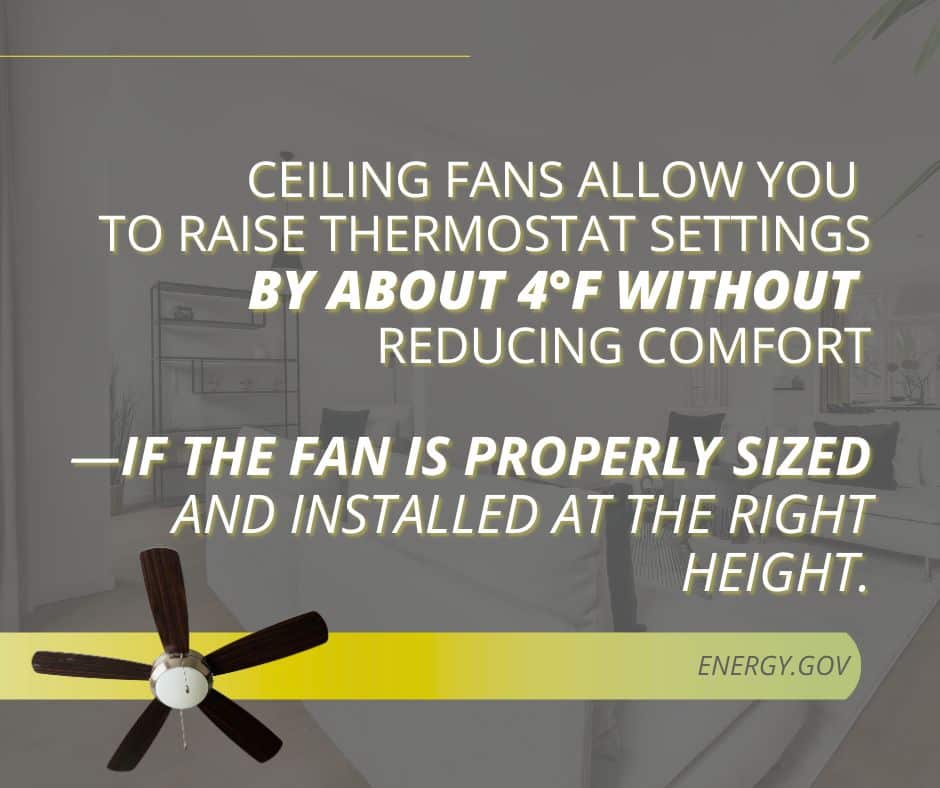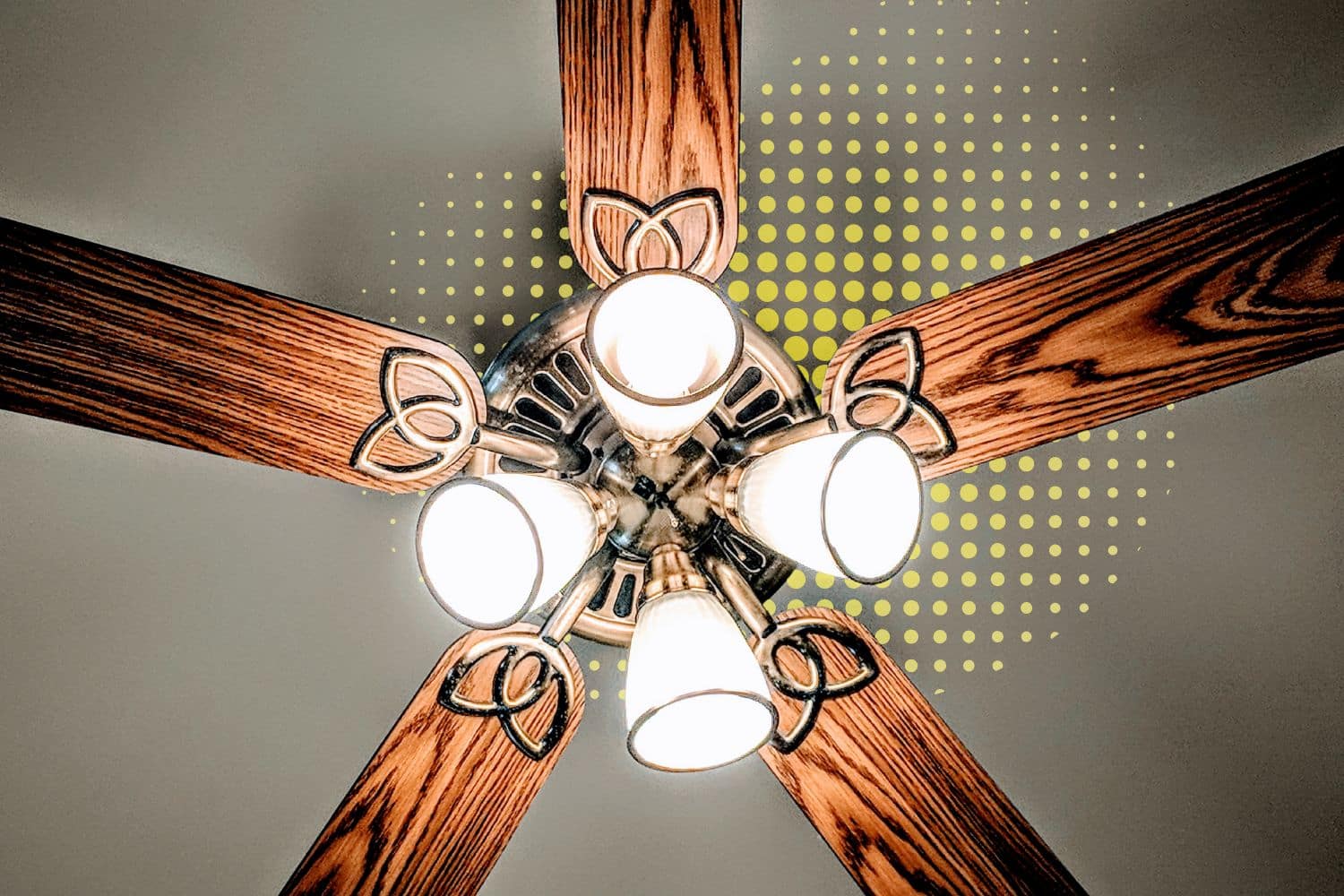A ceiling fan can make a room feel cooler in the summer and warmer in the winter. But the size of the fan matters more than most people think. This guide makes it easy to match fan size to your room with a simple ceiling fan size chart and a few extra tips.
Pick one that’s too small, and it won’t move enough air. Choose one that’s too big, and it might overpower the space or wobble while running. Here’s how to avoid both problems.
Why Fan Size Matters
Ceiling fans aren’t one-size-fits-all. The width of the blades (also called the fan’s diameter or “blade span”) plays a big role in how well it works in your space.
- A fan that’s too small may not move enough air, especially in rooms with high ceilings or poor airflow.
- A fan that’s too large may overwhelm the room visually or cause uncomfortable drafts.
Getting the size right also helps the motor work efficiently, which means longer-lasting performance and fewer annoying wobbles or noises.

Ceiling Fan Size Chart (Room Size vs. Blade Span)
Here’s a quick reference for picking the right ceiling fan size based on your room’s square footage:
| Room Size (Square Feet) | Suggested Fan Size (Blade Span) |
| Under 75 sq. ft. | 29″ to 36″ |
| 76–144 sq. ft. | 36″ to 42″ |
| 145–225 sq. ft. | 44″ to 50″ |
| 226–400 sq. ft. | 50″ to 54″ |
| Over 400 sq. ft. | 60″ or larger |
For rooms that are long or oddly shaped, you may need two smaller fans instead of one large one.
Ceiling Height Matters Too
Besides room size, you also need to think about ceiling height. Here’s how to choose the right mounting style:
- Low ceilings (under 8 ft): Use a flush-mount or “hugger” fan that sits close to the ceiling.
- Standard ceilings (8–10 ft): A fan with a short downrod (3–5 inches) works well.
- High ceilings (over 10 ft): Use a longer downrod to lower the fan to the right height. Ideally, fan blades should sit about 8 feet above the floor.
If you’re not sure about your ceiling height, a tape measure and a step stool are all you need.
Best Fan Placement by Room
Here are some quick tips for where and how to install ceiling fans throughout the home:
Living Room
Go with a 50- to 60-inch fan. If your living room is large, open-concept, or has high ceilings, consider a larger blade span and a downrod to improve air circulation.
Bedrooms
For most bedrooms, a 42- to 50-inch fan works well. Make sure the fan is centered over the bed or in the middle of the ceiling. Look for quiet motor options if noise is a concern.
Kitchens
Opt for a 36- to 44-inch fan. Keep blades away from cabinets or open flames. Some kitchen-friendly fans also include LED lighting or moisture-resistant finishes.
Bathrooms
Only install ceiling fans in bathrooms if the space is large enough and the fan is rated for damp or wet locations. Blade spans under 36 inches are best.
Offices or Dens
Use a fan around 42 inches for comfort without distracting airflow. Choose models with good lighting if the room needs overhead brightness.
Garages and Patios
For garages or covered outdoor spaces, use fans with durable, weather-resistant materials. Look for UL Wet or Damp ratings depending on exposure. Blade span should match the square footage.

Other Related Questions
How often should I clean or maintain my ceiling fan?
At a minimum, ceiling fans should be cleaned every few months to remove dust from the blades, which can affect balance and airflow. Check for loose screws or wobbling, especially if the fan is used daily.
Can a ceiling fan replace an air conditioner?
Not completely, but it can help reduce your AC use. Ceiling fans cool people, not rooms, by moving air across your skin. They can make a room feel 4 to 6 degrees cooler, which means you can raise the thermostat and still stay comfortable.
Do ceiling fans work in winter?
Yes. In colder months, reverse the fan’s direction so it spins clockwise. This pushes warm air down from the ceiling without creating a breeze. Just set it on the lowest speed.
What if my fan wobbles or makes noise?
Wobbling usually means the blades are out of balance. Try tightening all screws or using a balancing kit. If the noise persists, it could be the motor, mount, or even a loose box in the ceiling. A professional can check it during a general home inspection.
How do I know if a fan is too big for my room?
If the blades are within 18 inches of the nearest wall or feel visually overwhelming, it’s probably too large. This can cause uneven airflow, strain the motor, or feel uncomfortably drafty.
When to Call a Professional
If your ceiling fan isn’t working right, feels unstable, or you’re not sure it was installed properly, it’s time to bring in a pro. Loose connections, poor mounting, or faulty wiring can all be hidden issues.
During a full home inspection, we can check for safety hazards, electrical problems, and ventilation concerns throughout the house, not just at the fan.
We also recommend calling in help if:
- You’re upgrading multiple fans at once
- Your ceiling height makes installation tricky
- The current box isn’t rated for fan support
- You’ve noticed flickering lights or warm switches nearby
Conclusion
Choosing the right ceiling fan size can make your home more comfortable and efficient: with this chart, it’s easy. Pair it with a few room-by-room tips, and you can make sure your fan does its job without any surprises.
And if you’re buying a home, updating a room, or wondering whether your current systems and appliances are up to par, call InsideOut Inspections Plus. Our home inspections cover all the systems that keep your house safe and livable, including the ones spinning quietly overhead.


